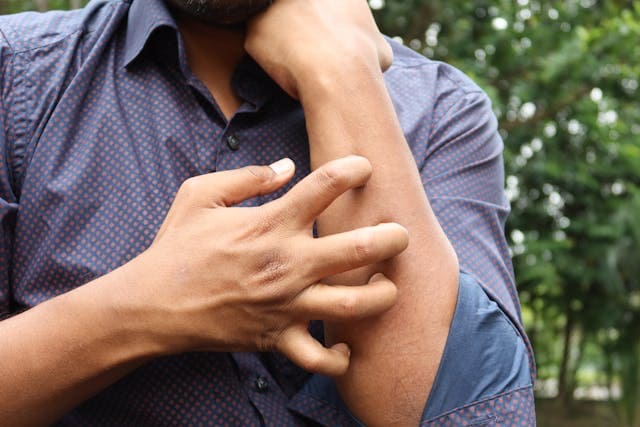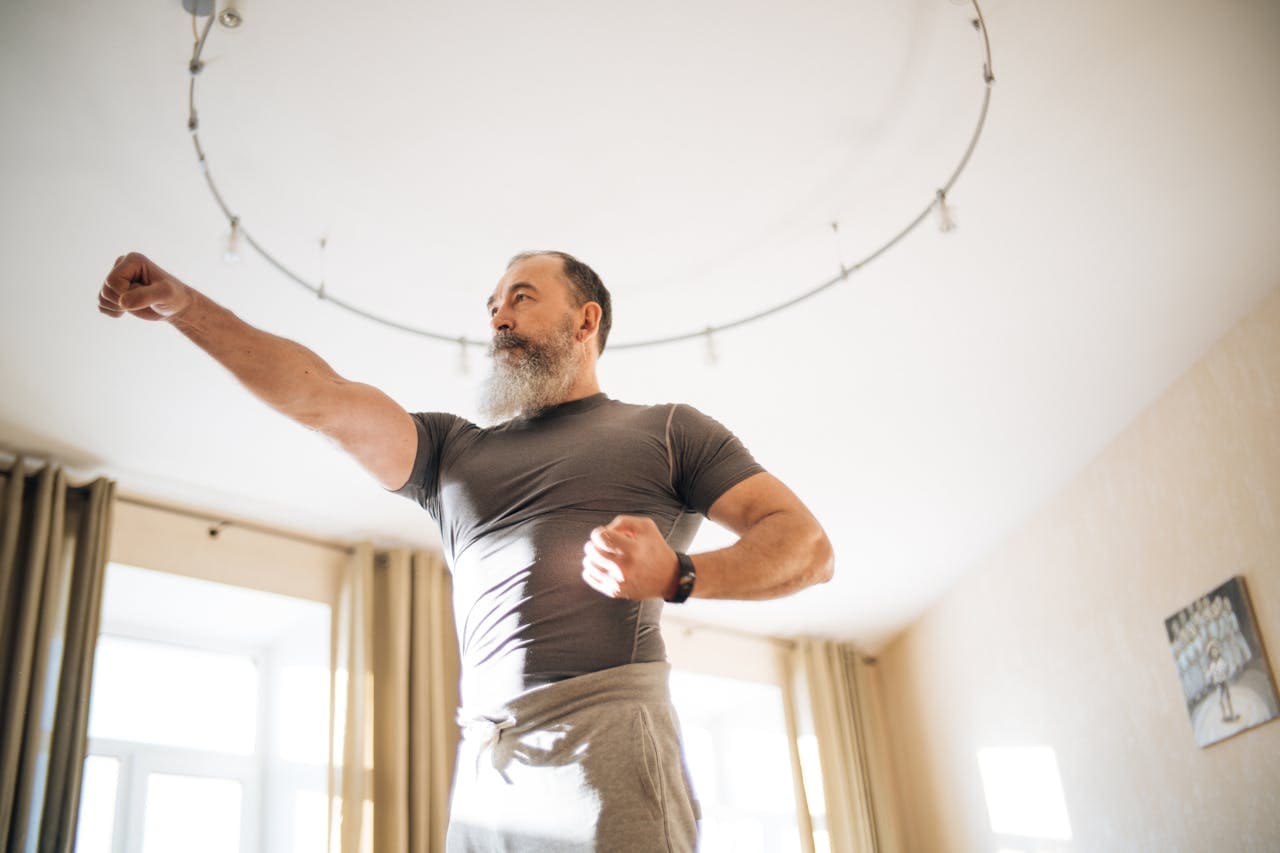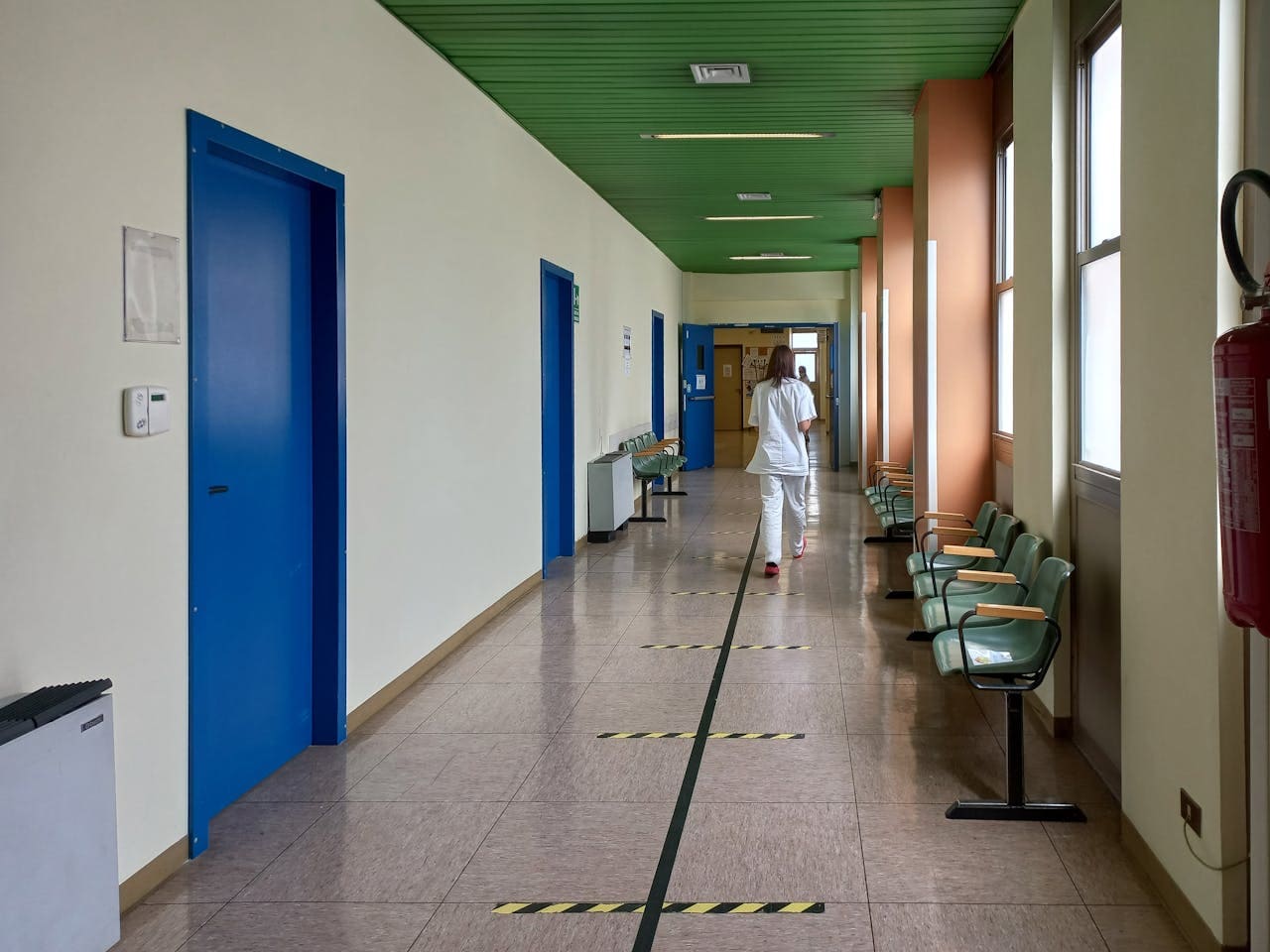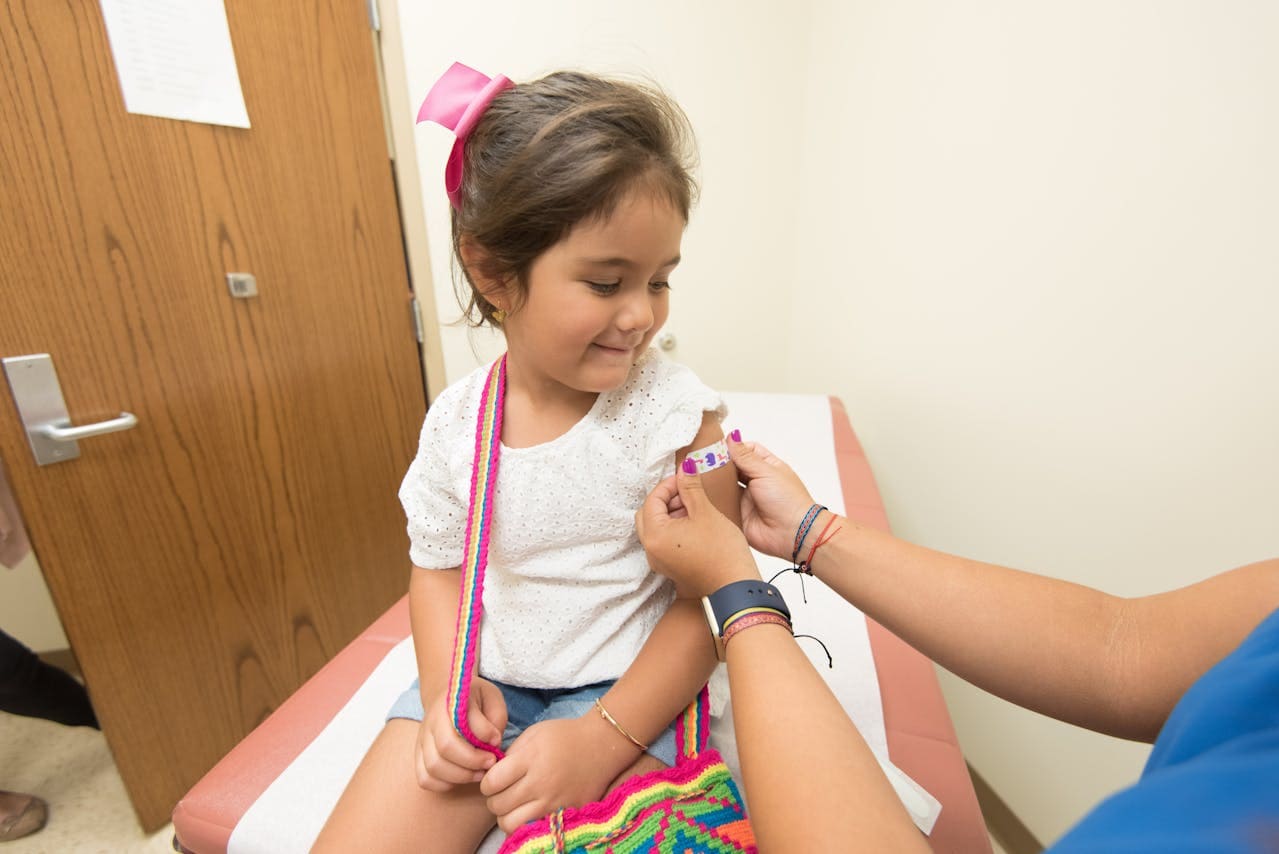
Online treatment for dermatitis, eczema & rashes
Get relief from itch, redness and flare-ups with an online visit. Consult a dermatologist (or GP) on Oladoctor, get a personalised care plan and — when appropriate — an e-prescription for topical therapy.
 Specialists available online (dermatologists & GPs)
Specialists available online (dermatologists & GPs) Share clear photos for a faster skin assessment
Share clear photos for a faster skin assessment Treatment options may include emollients, topical corticosteroids or calcineurin inhibitors
Treatment options may include emollients, topical corticosteroids or calcineurin inhibitors E-prescription issued when clinically indicated, usable at your local pharmacy
E-prescription issued when clinically indicated, usable at your local pharmacy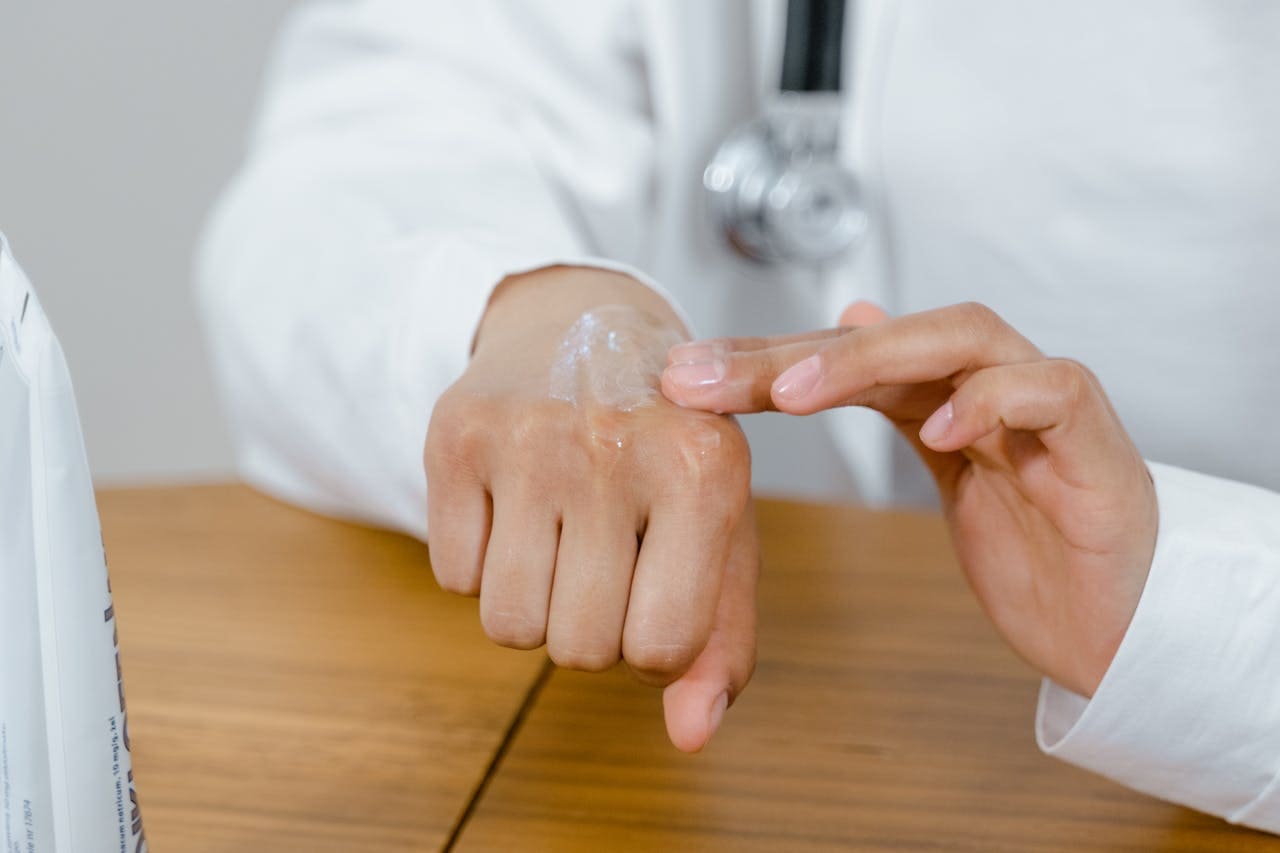
How online dermatitis care works
From booking to a personalised plan in one video visit.

Note: If you develop rapidly spreading redness, pus, high fever, severe pain, eye involvement or swelling of lips/face, seek urgent in-person care.
Choose a doctorDermatologists & GPs for dermatitis, eczema and rashes
Book a video consultation for atopic/contact dermatitis or unexplained rashes. Doctors on Oladoctor provide personalised plans and, when appropriate, e-prescriptions.
Dermatitis & eczema: symptoms, triggers and treatment guide
Evidence-based guide to dermatitis, eczema and rashes: symptoms and types, common causes and triggers, proven treatments (emollients, topical corticosteroids, calcineurin inhibitors), patch testing, safety and prevention.
Dermatitis, eczema or “rash”: what’s the difference?
Dermatitis means skin inflammation—redness, dryness, itch and sometimes flaky patches. Eczema is a common form of dermatitis that tends to flare (most often atopic dermatitis). People say “rash” for any new eruption; eczema is one cause, but infections, allergies, psoriasis or heat irritation can look similar.
- Atopic dermatitis: very itchy, dry patches in the bends of elbows/knees, on the neck or hands; relapsing course.
- Contact dermatitis: irritation or allergy to soaps, fragrances, nickel, hair dyes; appears where the skin touched the trigger.
- Seborrhoeic dermatitis: redness and fine scale on the scalp, eyebrows and sides of the nose (“dandruff” on the scalp).
- Nummular (discoid) eczema: coin-shaped itchy plaques on the limbs or trunk.
How to prep for an online skin review Take two photos per area: a sharp close-up (to show edges/scale) and a wider shot (to show location). Use natural light, no filters. Note when it started, any new products/jewellery/work exposures, and what you’ve already tried (emollients, steroid or calcineurin creams).
Further reading (authoritative, optional):
Everyday triggers & skin-care routine to reduce flares
Cut everyday irritants. The most frequent flare drivers are fragrance in skincare, harsh soaps, wool/rough fabrics, sweat/heat, and “wet work” (cleaning, catering, healthcare). Switch to fragrance-free products, use soap-substitute cleansers, wear breathable cotton, use nitrile gloves for wet tasks, and moisturise right after washing (see NHS eczema self-care) (source: NHS: Atopic eczema).
Moisturise like medicine. Emollients rebuild the barrier and reduce itch. Apply generously 2–3× daily and within 3 minutes after bathing (“soak & seal”). Many adults do well with urea 5–10% or ceramide creams; lighter lotions suit humid weather, thicker ointments help very dry skin.
Bathing & clothing habits. Keep showers lukewarm and short; avoid hot water and vigorous towel-rubbing (pat dry). Skip alcohol-based toners and harsh exfoliants. Prefer cotton layers over wool; rinse new clothes before first wear.
When it’s allergy, not just dryness. If the pattern maps exactly to where a product or object touches (watch strap, earrings, hair dye, specific cosmetics) or flares persist despite good emollient care, allergic contact dermatitis is possible. Ask about patch testing to common allergens (nickel, fragrance mixes, preservatives); primary-care dermatology guidance in Europe uses patch tests to confirm and tailor avoidance. PCDS: Clinical guidance (contact dermatitis & patch testing)
Sleep & itch control. Keep nails short, cool the bedroom, and try a brief cool compress on hot plaques before moisturising. Non-sedating antihistamines help mainly if hives are present; for pure eczema itch, barrier repair plus anti-inflammatory treatment works best.
Treatment ladder: from emollients to prescription creams
Most dermatitis care starts with daily emollients to rebuild the skin barrier. When flares break through, doctors on Oladoctor may add topical anti-inflammatories—choosing the right strength and right site matters more than the brand. As a rule of thumb, low-potency options suit the face, folds and groin, while medium potency is used on the trunk and limbs for short courses; very potent steroids are reserved for brief, targeted use on thick plaques. For sensitive areas or long-term maintenance, calcineurin inhibitors (tacrolimus, pimecrolimus) are steroid-sparing alternatives. Authoritative overviews: British Association of Dermatologists patient guide to topical corticosteroids and the EuroGuiDerm guideline for atopic eczema (adult).
Typical options your clinician may consider:
- Low potency (face/folds, short courses): hydrocortisone 1% cream; pimecrolimus 1% (Elidel®) or tacrolimus 0.03% (Protopic®) as steroid-sparing choices.
- Moderate potency (trunk/limbs, time-limited): hydrocortisone butyrate 0.1%, methylprednisolone aceponate 0.1% (Lexxema®), mometasone furoate 0.1% (Elocon®), betamethasone valerate 0.1% (e.g., Alergical®/Betnovate®).
- Very potent (short, focal bursts; not for face/folds): clobetasol propionate 0.05%.
- Steroid-sparing for delicate sites/maintenance: tacrolimus 0.1%/0.03% (Protopic®), pimecrolimus 1% (Elidel®).
Safety note, kept simple Potent steroids are time-limited and site-specific; avoid long continuous use on face/folds. Calcineurin inhibitors can sting at first use but are safe for delicate areas and for longer maintenance. Your doctor decides what’s appropriate for you and your country’s rules.
Safe use of topical treatments (so you clear flares without side-effects)
Topical therapy works when the potency matches the body site. Use low-potency medicines on the face, eyelids and skin folds; medium potency on the trunk and limbs for short courses; very potent options only as brief, targeted bursts on thick plaques. For delicate areas or longer maintenance, calcineurin inhibitors (tacrolimus, pimecrolimus) are steroid-sparing alternatives and a short, mild sting at first is common.
Dose by the fingertip-unit (FTU) rule instead of guessing a “thin layer”: one adult FTU (from fingertip to the first crease) covers about two adult palm areas. Using FTUs helps you apply enough medicine to switch off inflammation without overusing the tube.
Treat flares for a limited time (often 5–7 days with stronger preparations), then step down—lower the potency or reduce frequency—rather than stopping abruptly. If the same spots relapse, a proactive plan (e.g., twice-weekly on those areas) can cut flare frequency.
Apply to clean, dry skin, keep skincare fragrance-free, and avoid occlusion (tight dressings/film) unless specifically advised. Don’t use potent steroids on eyelids or in deep skin folds. Leave a short gap if layering with emollients.
If there’s no improvement after 7–10 days, or you notice spreading redness, oozing or crusts, recheck the plan with a clinician—potency, duration, site or even the diagnosis may need adjusting (source: Ireland’s Health Service Executive dosing & FTU guide).
Sensitive sites: eyelids & hands — how care differs
Eyelids. Skin here is thin and reactive, so keep the routine ultra-simple: lukewarm water or a gentle, fragrance-free cleanser, then a tiny amount of bland emollient. For flares, clinicians use very low-potency topicals for short courses or steroid-sparing options (tacrolimus/pimecrolimus) on medical advice. If symptoms map to mascara, nail varnish, hair dye or metal frames, think allergic contact dermatitis and remove likely culprits; persistent cases may need patch testing.
Hands. Frequent washing and “wet work” (cleaning, catering, healthcare) break the barrier. Swap harsh soaps for soap-substitute cleansers, moisturise after every wash, and use nitrile gloves (with cotton liners if you sweat). Short, time-limited courses of the right-potency topical calm flares; if rashes trace the outline of rings or gloves, suspect contact allergy (rubber accelerators, fragrance, preservatives) and consider patch testing.



















Your guide to healthcare in Europe
Practical information for getting care while living, working, or travelling in Europe — all in one place.
Dermatitis, eczema & rashes: frequently asked questions
Clear answers on symptoms and triggers, photo prep for online review, safe use of topical treatments, e-prescriptions (when appropriate), patch testing, and when in-person assessment is needed.


